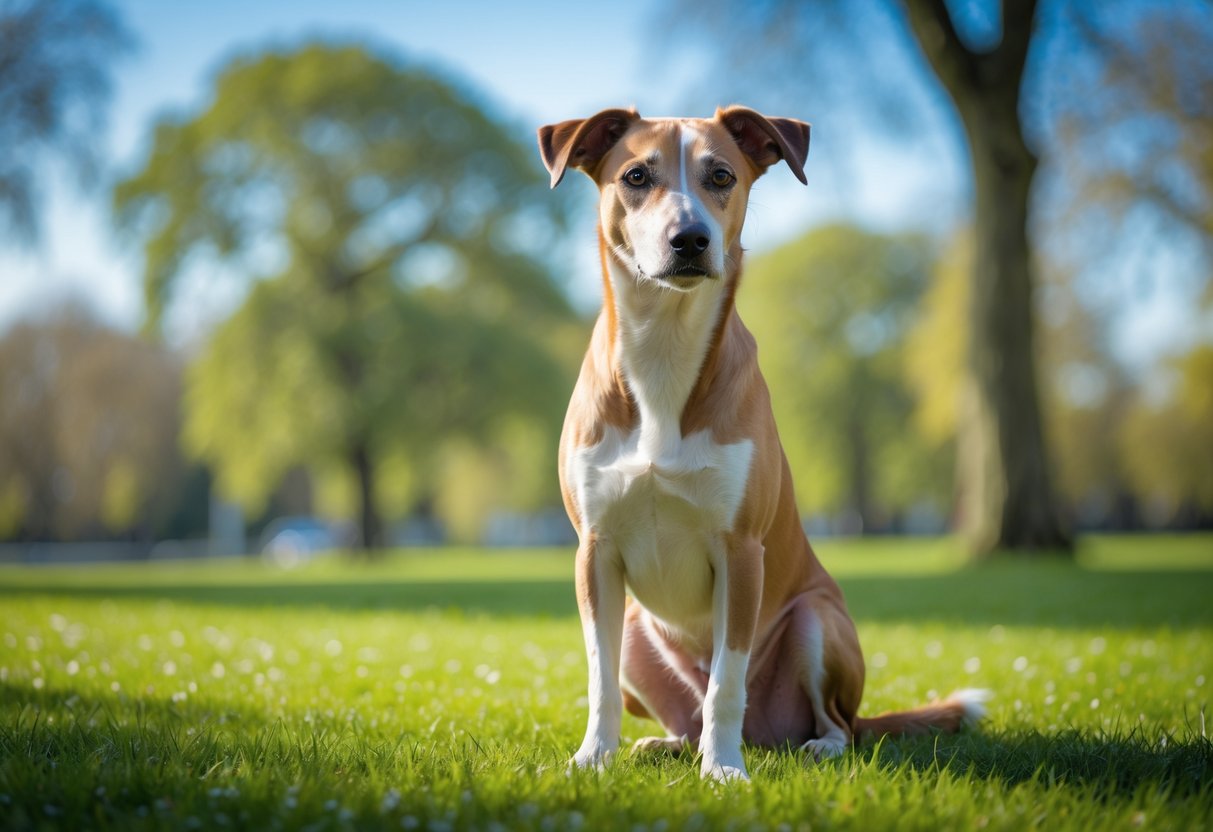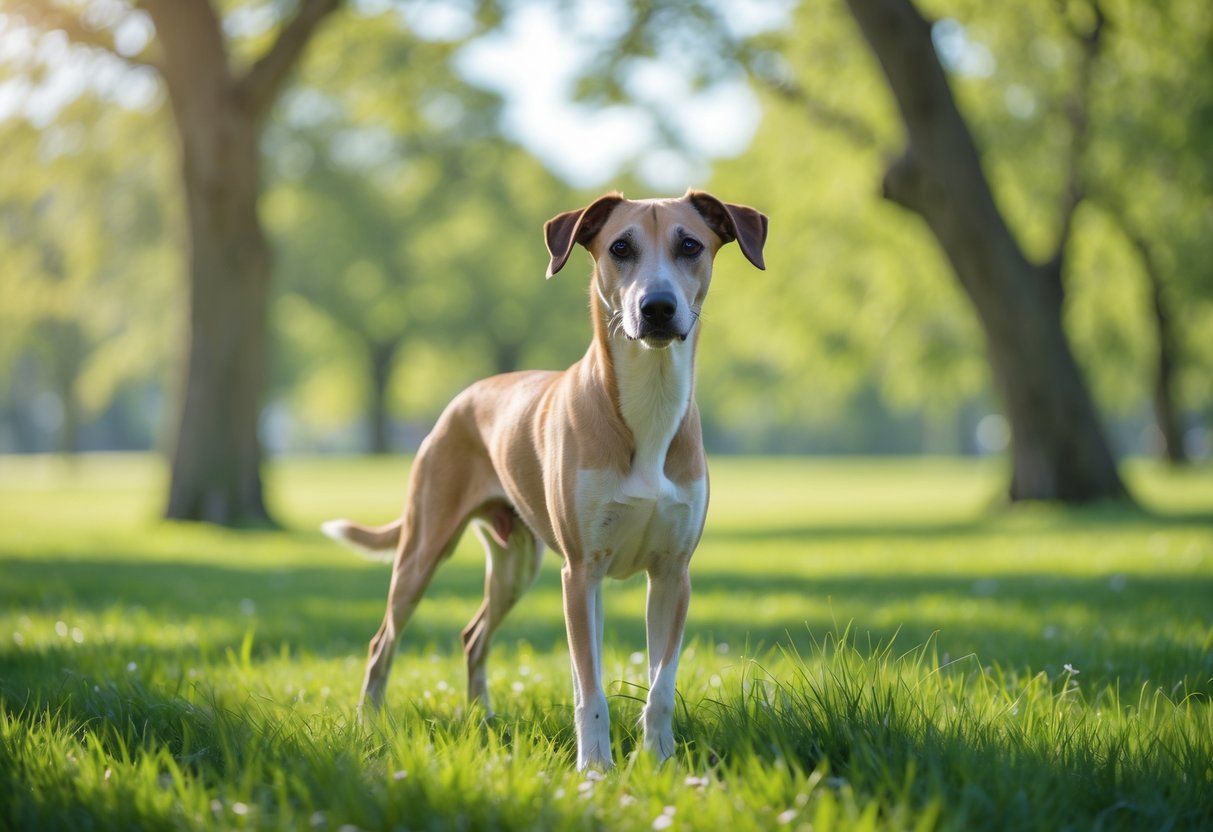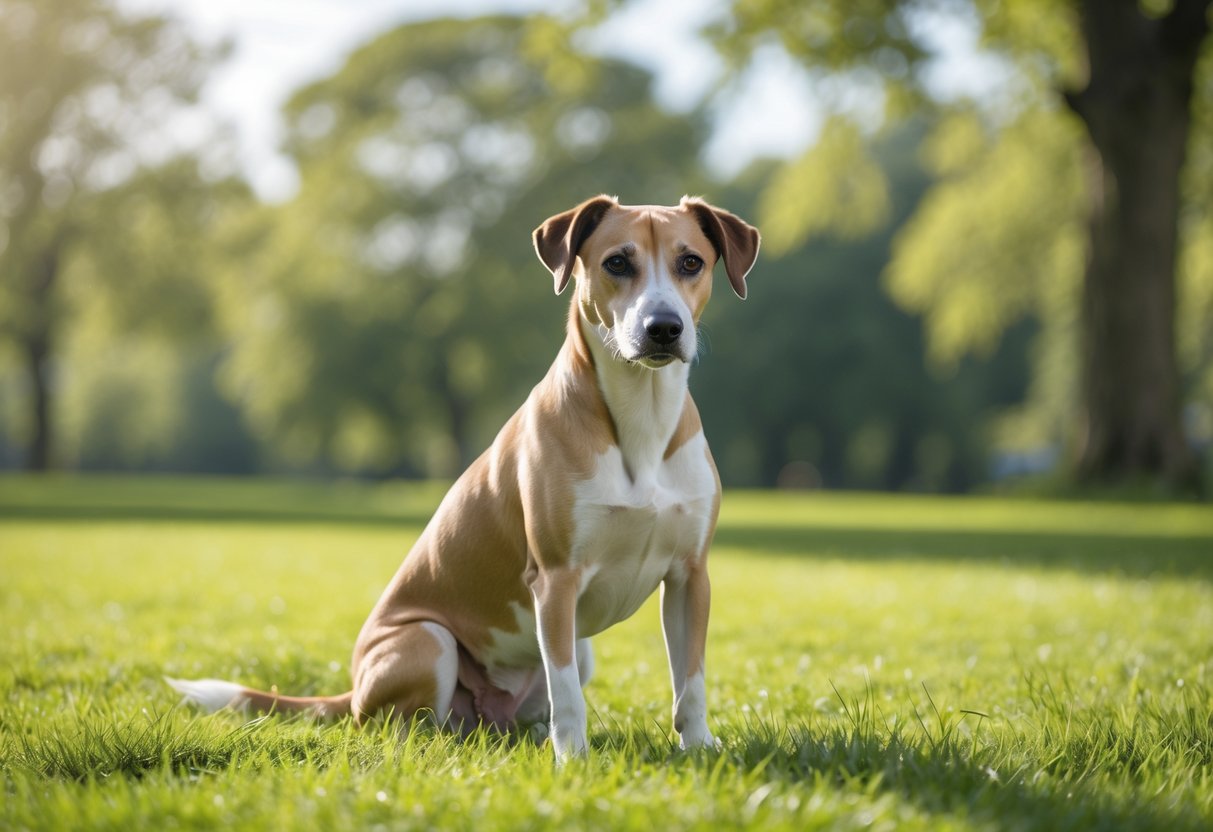If you’re curious about how long lurchers usually live, the answer’s actually pretty encouraging. Lurchers generally have a lifespan of 12 to 15 years when given good care.
Their mixed breed background often helps them stay healthy and live longer than some pure breeds.
Because lurchers are part sighthound and part working or terrier breed, their size, coat, and personality can vary quite a bit. This mix means that how long your lurcher lives depends on things like diet, exercise, and regular vet visits.
Understanding what makes them tick can help you give your dog the best chance of a long, happy life.
Key Takeaways
- Lurchers usually live between 12 and 15 years with proper care.
- Their mixed breed nature helps promote good health and longevity.
- Diet, exercise, and vet check-ups greatly affect how long they live.
Average Lifespan of Lurchers
When you own a lurcher, knowing how long they might live helps you plan for their care and companionship. Their lifespan is generally longer than many dog breeds, but it depends on several important factors.
Typical Age Range for Lurchers
Lurchers usually live between 12 and 15 years. This range is quite good compared to other dogs, thanks to their mixed breed background.
Some lurchers can even live beyond 15 years if they receive excellent care.
- Medium-sized dogs, weighing from 40 to 70 pounds, lurchers are generally healthy.
- Their lifespan benefits from something called hybrid vigour, which means mixing breeds can reduce the risk of some inherited health problems.
- Proper diet, regular exercise, and veterinary check-ups can help your lurcher reach the upper end of this lifespan range.
What Influences Lurcher Lifespan?
Several key things affect how long your lurcher will live. Genetics plays a big role here.
Since lurchers are crossbreeds between sighthounds and working dogs, their health can vary based on their parents’ genes. Your lurcher’s diet is also vital.
Feeding high-quality food that suits their lean build helps maintain a healthy weight and supports long-term health. Exercise matters, too.
Lurchers need at least 1 to 2 hours of physical activity every day. Running, walking, and playtime keep their muscles strong and minds sharp.
Regular vet visits for check-ups and vaccinations catch problems early. Conditions like hip dysplasia or heart issues are more manageable with timely care.
For more details about the lifespan and care needs of lurchers, see how long do lurchers live.
Understanding Lurchers as a Crossbreed
Lurchers aren’t a single dog breed but a type of crossbreed. Their looks, size, and health can change a lot, depending on the breeds mixed to create them.
This variety makes each lurcher unique in many ways.
Origins and Parent Breeds
Lurchers started in England around the 14th century. People bred them by mixing sighthounds with working breeds.
The main goal was to create fast and clever hunting dogs. Sighthounds like greyhounds are great at spotting and chasing prey quickly because of their speed.
Working dogs, such as terriers and collies, bring strength, stamina, and intelligence. This mix gave lurchers their special skills and helped them during hunting small animals like rabbits.
You can think of your lurcher as a blend of these qualities. The mix of parent breeds also means your dog may have different health needs and behaviours compared to pure breeds.
Common Crosses: Greyhound, Collie, and Terrier
The most common lurcher crosses include greyhounds, collies, and terriers.
- Greyhound: Adds speed, agility, and a lean body.
- Collie: Brings endurance, friendliness, and a thicker coat.
- Terrier: Offers boldness, toughness, and a wiry coat.
Your lurcher might look more like one breed or show features from all three. This mix affects not only appearance but how active your dog is and how much grooming they need.
The greyhound influence often means a short smooth coat, while terrier or collie genes can give longer, coarser fur.
Why Crossbreeds Can Vary in Longevity
Because lurchers come from many different backgrounds, their lifespan can differ. Crossbreeding sometimes leads to something called hybrid vigour, which can help your dog live longer and be healthier than pure breeds.
However, this depends on the health of both parent breeds. Mixed traits might protect against some illnesses but bring others.
For example, a greyhound’s speed is great, but they may be prone to bone issues. Meanwhile, collies can carry specific genetic conditions.
Understanding your lurcher’s family tree can help you care better for their health. For more details about lurcher lifespans, you can check out this guide to lurcher lifespan and care.
Key Factors That Affect Lurcher Longevity
Your lurcher’s lifespan depends on many things, from their genes to how you care for them every day. Paying attention to what they eat, how much exercise they get, and their mental needs all play a big role in helping them live a full, healthy life.
Genetics and Breed Mixture
Lurchers are crossbreeds, usually a mix of sighthounds like greyhounds and working dogs such as terriers or collies. This mix can give them what’s called hybrid vigour, which often helps reduce some inherited health problems and can lead to a longer life.
You still need to be aware of genetic health risks like hip dysplasia or heart conditions. These issues can come from any of the breeds involved in your dog’s ancestry.
Knowing your lurcher’s lineage can help you watch out for early signs and work with your vet to keep them healthy. Regular check-ups are important to catch problems early, especially since genetics affect a lot of your dog’s overall health and lifespan.
Diet and Nutrition
Feeding your lurcher a balanced, high-quality diet is key to long life. Because lurchers tend to be lean and athletic, they need food that supports their energy levels without causing weight gain.
Look for dog food rich in protein to support muscles, with the right fats for their coat and joint health. Overfeeding or giving too many treats can lead to obesity, which stresses the heart and joints and shortens lifespan.
You can also add supplements like glucosamine for joint support, especially if your lurcher is prone to hip issues. Always follow your vet’s advice and adjust food as your dog ages or changes activity levels.
Exercise and Mental Stimulation
Lurchers need about 1-2 hours of exercise a day to stay fit and happy. This can be running, walking, or even games like fetch.
Their sighthound blood means they love to sprint, so a safe, enclosed area is ideal. Mental stimulation matters too.
Puzzle toys, training sessions, and agility activities keep their minds sharp and prevent boredom, which might cause behaviour problems. Because lurchers are intelligent but independent, mixing physical exercise with mental challenges helps prevent stubbornness and keeps your dog motivated and healthy for years to come.
Common Health Issues in Lurchers
Lurchers are generally healthy dogs, but they can face some specific health problems. Keeping an eye on their inherited risks, how to spot and stop stomach twisting, and understanding signs of ageing can help you care for your lurcher better.
Inherited Conditions from Parent Breeds
Since lurchers come from a mix of sighthounds and other breeds, they may inherit health issues from both sides. Hip dysplasia is one condition where the hip joint doesn’t form properly.
This can cause pain and arthritis, especially as your dog grows older. Heart problems like dilated cardiomyopathy can affect larger lurchers with greyhound or deerhound ancestry.
Regular vet check-ups help find these issues early. You might also see thyroid problems, causing tiredness or weight gain, which vets can manage with medication.
Dental disease is common too, so brushing your lurcher’s teeth often helps prevent bad breath and tooth loss. Knowing these inherited risks lets you take the right steps to keep your dog happy and healthy.
Recognising and Preventing Gastric Torsion
Gastric torsion, or bloat, is a serious and fast-developing condition where your lurcher’s stomach twists. It cuts off blood flow and can be life-threatening without quick treatment.
Lurchers, with their deep chests, are more prone to this. You’ll notice sudden restlessness, bloated belly, drooling, or dry retching.
If your dog shows these signs, get to a vet immediately. To reduce risk, avoid feeding large meals once a day and don’t let your dog exercise vigorously right after eating.
Divide meals into smaller portions and keep water available but avoid gulping after exercise. Being alert and acting fast can save your dog’s life, so you must take these steps seriously.
Typical Signs of Ageing
As your Lurcher gets older, some health changes are just part of life. You might notice stiffness or limping from achy joints or arthritis.
This can make running or jumping a challenge for them. Your dog’s eyesight and hearing might fade a bit, so sometimes they’ll seem confused or bump into things.
Appetite and weight can shift, too. It’s normal, but it’s always worth keeping an eye out for big changes.
Give your older Lurcher gentle exercise and a comfy spot to rest. Regular vet visits help you catch issues early and keep your dog feeling okay in their senior years.
How to Extend Your Lurcher’s Lifespan
Keeping your Lurcher healthy and happy takes some attention to medical care, diet, and daily routines. Even small tweaks can really add up over the years.
Veterinary Care and Health Checks
Take your Lurcher to the vet regularly. These check-ups spot things like hip dysplasia, heart problems, or thyroid issues before they get serious.
Ask your vet to keep an eye out for bloat, since deep-chested Lurchers are at risk. If you know the warning signs, you can react quickly.
Stay on top of vaccinations, flea treatments, and dental care. Brush their teeth often, and book professional cleanings when needed.
Update treatment records and mention any odd changes in how your dog acts or eats. Your vet can help tailor care to your Lurcher’s unique mix.
Balanced Diet and Weight Management
Feed your Lurcher the right food for their size and energy. High-quality dog food made for large, active breeds works best.
Don’t overfeed—extra weight stresses their joints and organs. Try smaller, frequent meals to help prevent bloat.
Omega-3 fatty acid supplements are great for joints and a shiny coat. Keep an eye on their weight; you should feel their ribs, not see them.
If your dog’s weight changes suddenly or they lose their appetite, check in with your vet. It’s always better to ask than to worry.
Creating a Safe and Enriching Environment
Give your Lurcher a safe space to run and play. Avoid rough, hard ground—those fine bones don’t handle it well.
They need at least two hours of exercise a day. Mix in walks, playtime, and some brain games like scent work or training.
Groom regularly, especially ears, since Lurchers’ floppy ears can trap dirt. Check them weekly and keep them dry to avoid infections.
Make sure your dog has a calm place to rest and stays out of extreme weather. Keep toxic plants and dangerous stuff out of reach.
If you want more details, check out this page on Lurcher health and lifespan.
Lifestyle and The Role of Working Dog Heritage
Lurchers are a mix of working breeds, so their active backgrounds shape their needs. Their health and behavior really tie back to this heritage.
Caring for them means understanding these quirks. How you handle exercise and health checks makes a real difference.
Exercise Needs and Agility Activities
Your Lurcher needs exercise that matches their natural speed and stamina. They don’t just want a stroll—they crave sprints and running in safe spots.
Try agility courses or fetch to keep them sharp and quick. These activities help their muscles and joints, and lower injury risks.
Go for daily bursts of fast running plus some longer, relaxed walks. Without enough exercise, Lurchers can get bored or act out—nobody wants that.
Impact of Working Dog Lineage on Health
Lurchers inherit health traits built for endurance and speed. Watch for issues common in sighthounds and working dogs—like hip dysplasia, bloat, or joint problems.
Their lean build and sensitive skin can lead to cuts or paw injuries, so check them over regularly. Heart health matters, too, especially with larger sighthound ancestry.
Vet check-ups are your best bet for catching problems early and keeping your Lurcher in good shape.
Adapting Care for Senior Lurchers
When your Lurcher ages, their working-dog side means you’ll have to adjust how you care for them. Exercise should be gentler but still regular—think shorter walks and less intense running.
This keeps joints moving without extra pain. Diet needs may shift, too, with food that supports joints and keeps weight steady.
Supplements like omega-3s can help with inflammation. Watch for stiffness or slower movement; early vet advice can make a big difference for comfort.
Frequently Asked Questions
Lurchers usually live a good, long life. Their years with you depend on things like size, health, and the care you give.
What’s the typical lifespan of a lurcher?
Most lurchers make it to 12–15 years. The right care and lifestyle help them reach the higher end of that range.
How many years can you expect your lurcher to be part of your family?
With good care, expect your lurcher to stick around for about 12–15 years. That’s a lot of time for walks, play, and plenty of company.
Are there health concerns that can affect how long lurchers live?
Lurchers are generally healthy thanks to their mixed breeds, but their slim, active build means they can get things like sprains or nail injuries.
What can we do to ensure our lurchers have a long and healthy life?
Feed them a balanced diet, keep up with vet visits, and give them safe exercise in enclosed spaces. All these help keep your Lurcher fit and happy.
Does the size of a lurcher influence its overall lifespan?
Size matters a bit—bigger dogs need more food and attention. But honestly, good care is what really matters for a longer life, no matter the size.
What sort of care should we give our lurchers to help them thrive in their golden years?
When your lurcher starts to age, think about what really matters to them. They need gentle exercise and regular health checks.
Give them a calm, loving home. That’s honestly the heart of keeping them happy and well as they grow older.








